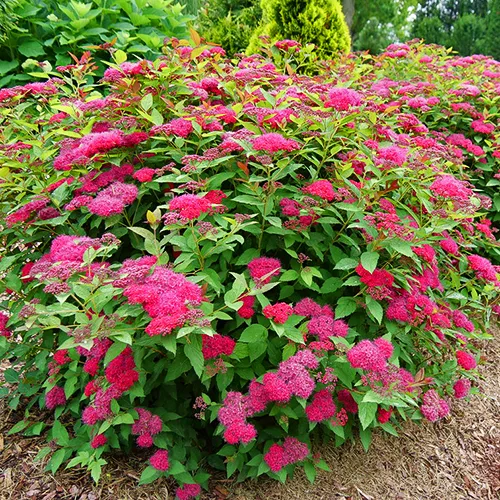Landscaping With Pink Spiraea
Pink Spiraea known as Spiraea japonica represents a captivating deciduous shrub that holds a deep historical legacy. This plant originated in eastern Asia which includes China, Japan, and Korea and people have cultivated it for hundreds of years because it looks good and grows well in different conditions. Once documented in early botanical texts the plant emerged as a favored choice among gardeners and horticulturists. In ancient Chinese and Japanese landscapes, japonica became a popular choice due to its delicate flowers clustering together and graceful arching growth form.
Between the 18th and 19th centuries japonica reached Europe and gained popularity because it could grow in different environments. The durability and persistent flowering of the species caught the attention of European plant collectors. By the turn of the 19th century japonica had become widely used as an ornamental shrub in many private gardens and public parks. The plant made its way to North America where landscape designers appreciated its durable nature and vivid pink coloration. The plant holds substantial historical importance in traditional Japanese gardens while maintaining its role in classical landscape designs and symbolizing natural beauty.
Pink Spiraea Traditional and Modern Medicinal Uses
The japonica plant has been a key component of herbal medicine throughout Asian traditional practices for hundreds of years. Ancient Chinese healers utilized plant extracts to leverage their anti-inflammatory and pain-relieving effects. People commonly used tea steeped from leaves and flowers to treat fevers, headaches, and digestive issues. Its inherent astringent properties made it useful for treating small wounds and skin issues because it reduced swelling and supported healing processes.
Japanese herbal practitioners value this plant for its ability to enhance blood circulation and use it in treatments for joint pain and rheumatic conditions. Recent scientific studies have found antioxidant compounds in Pink Spiraea which suggest its possible use in natural and holistic medicinal practices. Herbalists and natural healers still investigate its uses today especially for topical treatments and traditional herbal infusions although its presence in mainstream medicine has decreased.
Pink Spiraea Discovery and Introduction to the Western World
Historical records show that japonica emerged naturally from forested regions, open meadows and riverbanks across Asia during ancient times. Early botanists who recorded japonica in Japan and China were amazed by its striking flowers and distinctive leaf patterns. The 18th-century European explorers together with plant collectors entered Asia because of its abundant natural diversity. During their Asian exploration missions European collectors brought japonica back to Europe for examination and garden planting.
Botanical literature officially classified it as a species during the early 19th century, and Western botanical gardens were introduced to it. The plant's ornamental potential became clear to gardeners who then started cultivating it throughout Europe and North America. The plant thrived in numerous climates and held great visual appeal which led to its widespread adoption in diverse garden designs including both formal Victorian settings and naturalistic environments.

A Versatile Landscape Feature
Pink Spiraea functions as both versatile and dependable in contemporary landscape designs. With a typical height range of two to four feet, this shrub is perfectly suited for use in border plantings, foundation plantings, and mixed perennial beds. Clusters of bright pink flowers on the plant stand out against its green-blue foliage. These blossoms extend their presence from late spring until summer which maintains garden interest throughout multiple seasons.
The minimal care japonica needs stands out as one of its attractive features. This plant flourishes across many soil types and develops drought resistance once mature while responding positively to pruning which stimulates full and vigorous blooming. Urban plantings benefit from this plant because landscape designers choose it for its ability to endure pollution and environmental stressors. Mass plantings often utilize this plant because its intense floral display generates a striking visual effect.
The Appearance of Pink Spiraea
Its physical features enable japonica to become a standout feature in any garden space. The diminutive ovate leaves of the plant display finely serrated edges, which contribute to the texture of garden designs. During autumn months the foliage displays golden and reddish shades which extend its appeal beyond just its floral presentation.
The abundant pink blossoms serve as the main feature that stands out on this shrub. A corymb flower cluster features multiple small flowers which draw different types of pollinators. A gentle yet dramatic appearance from these flowers brightens garden areas through their blend of fragile and powerful display. Varieties of japonica can display vibrant magenta shades in some cases whereas others present softer pastel pink tones.
A Haven for Rare Wildlife
Although pink spiraea japonica receives widespread admiration for its aesthetic appeal it simultaneously fulfills a critical function in sustaining wildlife populations. The nectar-rich blooms of the plant draw in numerous pollinating insects such as bees as well as butterflies and moths. Japonica's inclusion in pollinator-friendly gardens proves beneficial because it helps sustain bee populations that are currently diminishing.